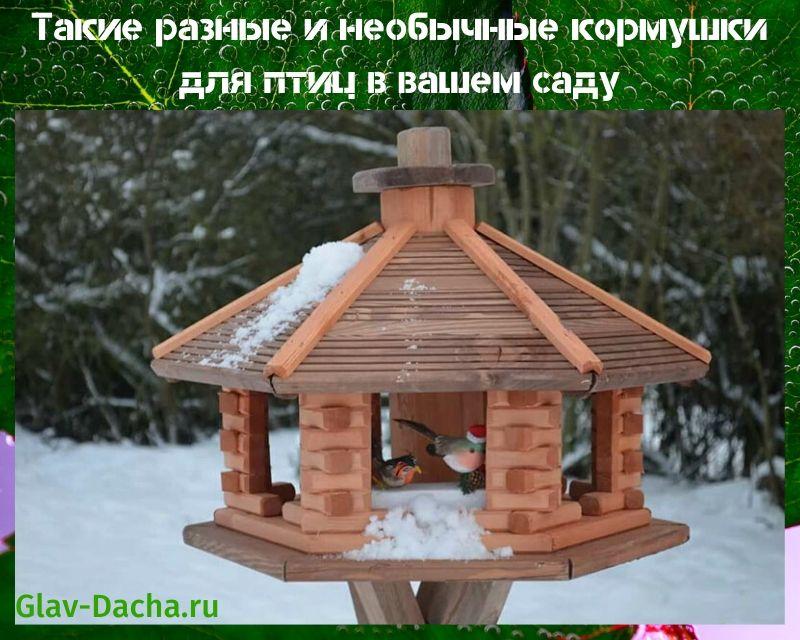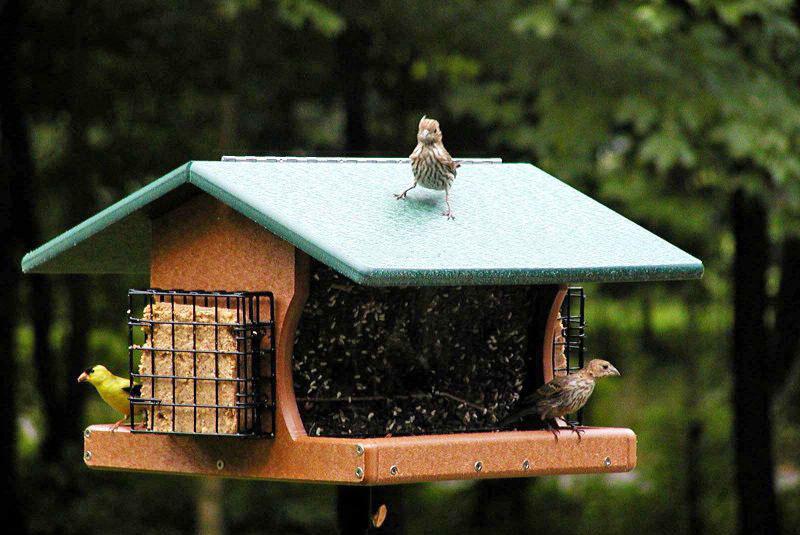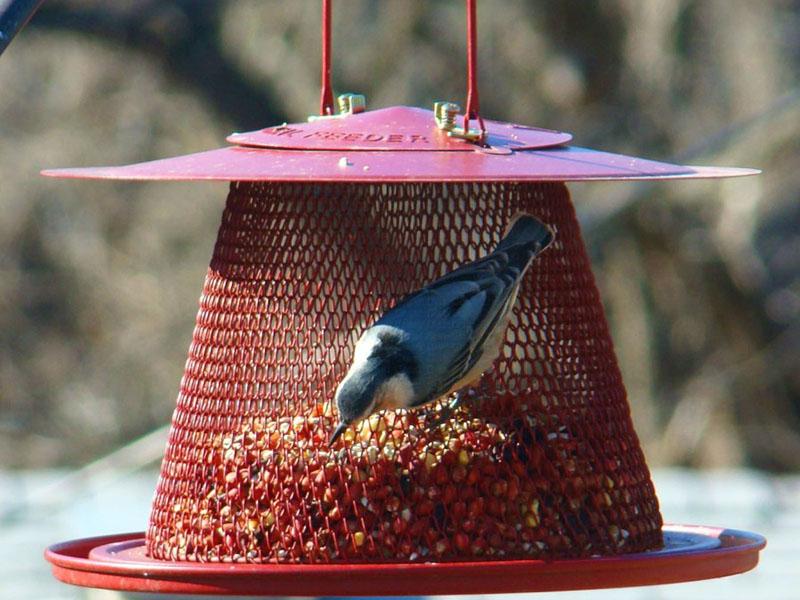Such different and unusual bird feeders in your garden
 In the cold, especially winter season, it becomes difficult for birds to find food for themselves, and they desperately need strength for life. Man-made bird feeders placed on trees in gardens, parks, or near residential buildings (even by a window, balcony) will save birds from hunger and help them survive severe frosts.
In the cold, especially winter season, it becomes difficult for birds to find food for themselves, and they desperately need strength for life. Man-made bird feeders placed on trees in gardens, parks, or near residential buildings (even by a window, balcony) will save birds from hunger and help them survive severe frosts. 
Where to place bird feeders
 Unlike birdhouses, which need to be placed in quiet, remote locations, feeders should be hung in prominent and open areas. The birds will immediately notice the food and will regularly visit the “feeding point”.
Unlike birdhouses, which need to be placed in quiet, remote locations, feeders should be hung in prominent and open areas. The birds will immediately notice the food and will regularly visit the “feeding point”.
Suitable for this:
- squares and parks;
- courtyards of residential buildings;
- roofs of houses;
- garden in a country house.
 Feeders are suspended, fixed to the branches of trees, bushes or on loggias, balconies, terraces, windows. When choosing the last options, you can watch the birds without leaving your home, it is very interesting and informative for children.
Feeders are suspended, fixed to the branches of trees, bushes or on loggias, balconies, terraces, windows. When choosing the last options, you can watch the birds without leaving your home, it is very interesting and informative for children.
On this topic:do-it-yourself birdhouse drawings and dimensions!
What materials are suitable for making bird feeders
For the manufacture of feeders, you can use various materials, which greatly simplifies the implementation of the plan:
- cardboard boxes and packages;
- metal cans;

- plastic, plastic;

- wood;

- durable mesh;
- glass and porcelain;

- vegetables or fruits (by removing the pulp) as a container for filling.

For fixing, you can use ropes, fishing lines, laces, wire. Do not forget that for the convenience of birds they always make small "roosts". For this, sticks for ice cream, pieces of plastic or wood, twigs, chips are suitable.
Fruit and vegetable
 The easiest option, which does not require any costs, is to use pumpkin, coconut (by removing the pulp), citrus peel. Often people do not hesitate to throw out peelings after oranges, pumpkins, and other fruits and vegetables. And they can be perfectly used under an organic feeder, filling them with seeds and hanging them on tree branches.
The easiest option, which does not require any costs, is to use pumpkin, coconut (by removing the pulp), citrus peel. Often people do not hesitate to throw out peelings after oranges, pumpkins, and other fruits and vegetables. And they can be perfectly used under an organic feeder, filling them with seeds and hanging them on tree branches.
Carton packaging
 Making a feeder from a cardboard container is the easiest and cheapest option. Boxes for dairy products, juices, shoes, equipment are suitable. Windows are made in a box with scissors or a clerical knife, feed is poured: seeds, grains, bacon, cookies, bread. Then they are hung on bushes or trees, fences and other places.
Making a feeder from a cardboard container is the easiest and cheapest option. Boxes for dairy products, juices, shoes, equipment are suitable. Windows are made in a box with scissors or a clerical knife, feed is poured: seeds, grains, bacon, cookies, bread. Then they are hung on bushes or trees, fences and other places.
Plastic bottles
 Bird feeders are often made from plastic bottles, it is also completely inexpensive and easy. Just as in the version with cardboard, they make openings for the birds, insert sticks or twigs so that the birds are comfortable to sit, fill in the food and fix it in the chosen place.
Bird feeders are often made from plastic bottles, it is also completely inexpensive and easy. Just as in the version with cardboard, they make openings for the birds, insert sticks or twigs so that the birds are comfortable to sit, fill in the food and fix it in the chosen place.
When choosing a plastic bottle feeder, you should not forget that this material is very sharp at the cut sites. To prevent the birds from cutting themselves, it is imperative to "sand" all sharp cuts, or seal them with electrical tape (resistant to bad weather).
Metallic option
 A simple solution is a can trough. This container is washed, dried and processed or folded over all sharp edges. If desired, the can is painted, wooden or plastic strips are glued (it is better to refuse metal) for a convenient location of the birds. The prepared container is attached to branches or, with the help of self-tapping screws, is fixed to fences, posts. Then feed is poured.
A simple solution is a can trough. This container is washed, dried and processed or folded over all sharp edges. If desired, the can is painted, wooden or plastic strips are glued (it is better to refuse metal) for a convenient location of the birds. The prepared container is attached to branches or, with the help of self-tapping screws, is fixed to fences, posts. Then feed is poured.
Wood bird feeders
 The classic version of a wooden feeder should be chosen if there are children in the house. This will contribute to the interest of kids in caring for birds, fostering a sense of responsibility and kindness. A wood feeder always looks very impressive, you can make it yourself of any size and shape.
The classic version of a wooden feeder should be chosen if there are children in the house. This will contribute to the interest of kids in caring for birds, fostering a sense of responsibility and kindness. A wood feeder always looks very impressive, you can make it yourself of any size and shape.
For this:
- Create a preliminary sketch on paper with a pencil (in the form of a house).
- Plywood blanks are made according to the sketch.
- They assemble the structure - knocking it together, gluing it together, and fixing all the elements.
- They choose a place and fix the bird feeder with strong fasteners, since this structure is heavier.
 Seeds, cereals, dried fruits and lard are poured into the finished feeder. You can often see several wooden feeders (5-6 pcs.) Installed in parks or courtyards at once.
Seeds, cereals, dried fruits and lard are poured into the finished feeder. You can often see several wooden feeders (5-6 pcs.) Installed in parks or courtyards at once.
The bottom of a hand-made wooden feeder should be made heavier so that the structure does not overturn in strong winds (for suspended versions). To do this, choose small stones that are laid flat on the bottom, or a steel sheet of the required size.
Non-standard options
In addition to the commonly used and simple feeders, you can choose an original solution that will not only benefit the birds, but also add additional decor to the overall design of your yard or garden.
Porcelain constructions
 It often happens that a cup or plate accidentally breaks and is thrown away. In the meantime, there are good ideas on how to give the broken dishes a second life - to use them for the feeder. The broken parts are glued together, the cup is glued horizontally to a saucer or plate - done! It remains to fix in the chosen place and fill the food. You can only use cups, fixing them to a base, for example, a board. You can also use shades, glass jars.
It often happens that a cup or plate accidentally breaks and is thrown away. In the meantime, there are good ideas on how to give the broken dishes a second life - to use them for the feeder. The broken parts are glued together, the cup is glued horizontally to a saucer or plate - done! It remains to fix in the chosen place and fill the food. You can only use cups, fixing them to a base, for example, a board. You can also use shades, glass jars.
Mixed feeder
 Original bird feeders will be visited daily if they are made in a non-standard way with minimal costs. To do this, make sugar syrup or dough from flour, water and protein. Seeds, nuts, grains, dried fruits, fruits (cut) are poured into this sticky mass. Everything is mixed and laid out in strong plastic nets. A ready-made treat for birds is hung on the branches.
Original bird feeders will be visited daily if they are made in a non-standard way with minimal costs. To do this, make sugar syrup or dough from flour, water and protein. Seeds, nuts, grains, dried fruits, fruits (cut) are poured into this sticky mass. Everything is mixed and laid out in strong plastic nets. A ready-made treat for birds is hung on the branches.
Having placed the feeder in a certain place, you should not forget that it is always filled with food, as the birds will get used to it and will regularly visit there.

Bunker structures
 If it is not possible to fill the trough on a daily basis, you can choose the right solution - the bunker option. This trough features a large, closed, capacious feed tank and small feed recesses. As the birds eat the grains, seeds, gradually the food will be fed again and again (automatically). In this option, it is very important not to forget to make a convenient additional area for the location of the birds, as in the photo.
If it is not possible to fill the trough on a daily basis, you can choose the right solution - the bunker option. This trough features a large, closed, capacious feed tank and small feed recesses. As the birds eat the grains, seeds, gradually the food will be fed again and again (automatically). In this option, it is very important not to forget to make a convenient additional area for the location of the birds, as in the photo.
When installing a bird feeder, it should be borne in mind that the location of the structure should not be on the leeward side - food and birds will blow away. The bird house should be safe for birds (no sharp edges), securely fixed, easy to use, and protected from bad weather. Its location should be accessible for a person who will add food, and inaccessible for cats.
Photo selection of original feeders












My daughter and I plan to make a bird feeder with our own hands this year! Thank you for the inspiration! We will deal with this issue in the coming days!)